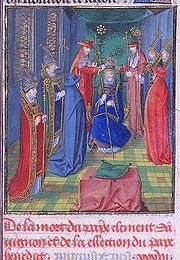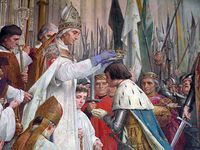Papal Coronation
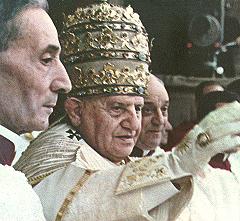
A Papal Coronation is the ceremony of the placing of the Papal Tiara on a newly-elected pope. The first recorded papal coronation was that of Pope Celestine II in 1143. Soon after his coronation in 1963, Pope Paul VI abandoned the practice of wearing the tiara. None of his successors have chosen to resume the practice and, accordingly, there has been no further papal coronation.
Contents |
Ritual
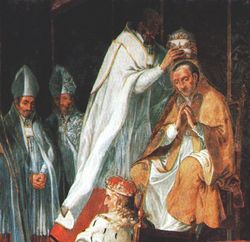
When a conclave elects a new pope, he assumes all of the rights and authority of the papacy immediately upon his acceptance of election; however, popes traditionally numbered their regnal years from the date of their coronation.[1] Since the Pontificate of Pope John XXIII, all cardinals must be bishops, and for several centuries the cardinals have always elected one of their own to be pope. If a newly-elected pope is not a bishop, he is consecrated at once. In accordance with tradition, the right of consecration belongs to the Dean of the College of Cardinals, in his absence to the Subdean, and in the absence of both of these, to the senior Cardinal Bishop.[2] If the new pope is already a bishop, his election is announced immediately to the people gathered in Saint Peter's Square and he gives them his blessing.
The episcopal enthronement of the pope takes place in his cathedral, the Basilica of Saint John Lateran. This ceremony was once combined with the coronation. During the Avignon papacy, the pope, being in France, could not be enthroned in his cathedral in Rome. The coronations continued, while enthronements had to await a return to Rome. When Pope Gregory XI did return to Rome, the Lateran Palace was badly in need of repair, so the Popes made the Vatican their residence and transferred coronations to Saint Peter's Basilica. The Lateran Basilica remains the cathedral of Rome, and the enthronement occurs there.[3] During the "prisoner in the Vatican" period, the enthronement did not take place.
Coronation Mass
The coronation took place on the first Sunday or Holy Day following the election. It began with a solemn Papal Mass. During the chanting of Terce, he sat on a throne and all of the cardinals made what was called their "first obeisance" to him, approaching one by one and kissing his hand. Then the archbishops and bishops approached and kissed his feet.
Following this, at least from the beginning of the sixteenth century, the newly-elected pope was carried in state through St. Peter's Basilica on the sedia gestatoria, under a white canopy, with the papal flabella (ceremonial fans) to either side. Instead of the papal tiara, he wore a jewelled mitre (the episcopal mitra pretiosa). Three times, the procession was stopped, and a bundle of flax lashed to a gilded staff was burnt before the newly-elected pontiff, while a master of ceremonies said: Pater Sancte, sic transit gloria mundi (Holy Father, thus passes the glory of the world) as a symbolic caution to set aside materialism and vanity.[4] Once at the high altar, he would celebrate Solemn High Mass with full papal ceremonial.
After the Confiteor, the pope was seated on a throne and the three senior cardinal bishops approached him wearing mitres. Each in turn placed his hands above him and said the prayer, Super electum Pontificem (over the elected pope). Then the senior cardinal deacon placed the pallium on his shoulders saying:
Accept the pallium, representing the plenitude of the Pontifical office, to the honour of Allmighty God, and the most glorious Virgin Mary, his Mother, and the Blessed Apostles Peter and Paul, and the Holy Roman Church.
In the eleventh and twelfth centuries the immantatio, or bestowal of the mantum (a papal vestment consisting of a very long red cope fastened with an elaborate morse) on the newly elected pope was regarded as especially symbolic of investiture with papal authority, and was conferred with the words: "I invest thee with the Roman papacy, that thou rule over the city and the world."[5]
After the investiture (whether with the pallium or the mantum) the pope again received the obeisance of the cardinals, archbishops and bishops. Then the Mass continued, and the Litany of the Saints was chanted.
Coronation
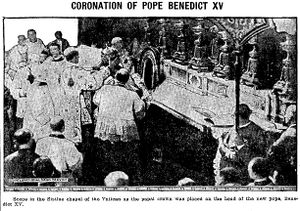
The Humeston New Era (Iowa newspaper)
After the Mass, the new pope was crowned with the papal tiara. This frequently took place on the balcony of St. Peter's Basilica, overlooking the crowds gathered in St. Peter's Square. The pope was seated on a throne with the flabella to either side of him. His mitre was removed, and the tiara was presented to the pope by the senior cardinal deacon, with the words:
Receive the tiara adorned with three crowns and know that thou art Father of Princes and Kings, Ruler of the World, Vicar of our Savior Jesus Christ in earth, to Whom is honor and glory in the ages of ages.
Then he solemnly placed the tiara on the pope's head, and arranged the lappets behind his neck.
Following his coronation, the pope pronounced the solemn pontifical blessing, Urbi et Orbi.
Possession of the cathedra of the Bishop of Rome
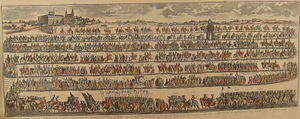
The last act of the inauguration of a new pope is still the formal taking possession (possessio) of his cathedra as Bishop of Rome in the Basilica of St. John Lateran. This is the final ceremony mentioned in Pope John Paul II's Apostolic Constitution on the vacancy of the Apostolic See and the election of the Roman Pontiff.[6] The pope is enthroned in the same manner as other bishops. He is solemnly conducted to the episcopal throne, and takes possession by seating himself on it. He receives the kiss of peace and listens to the reading of a passage of Holy Scripture, whereupon he pronounced an address that used to be called the sermo inthronisticus.
In ancient times, the letters that the pope sent to the patriarchs in token of being in communion with them in the same faith were called litteræ inthronisticæ, or syllabai enthronistikai.[7]
Location of the ceremony
The earliest papal coronations took place in St. John Lateran, the pope's cathedral. However, for hundreds of years papal coronations have traditionally taken place in the environs of St. Peter's Basilica, though a number of coronations took place in Avignon, during the Avignon papacy. In 1800 Pope Pius VII was crowned in the crowded church of the Benedictine island monastery of San Giorgio, Venice, after his late predecessor, Pope Pius VI, had been forced into temporary exile during Napoleon Bonaparte's capture of Rome. Since the French seized the tiara along with the previous pope, he was crowned with a papier-mâché tiara, for which the ladies of Venice gave up their jewels.
All coronations after 1800 took place in Rome. Until the mid 19th century popes were crowned in St. John Lateran. However public hostility to the Pope in Rome led to the ceremony being moved to the safer St. Peter's Basilica. Leo XIII was crowned in the Sistine Chapel,[8] due to fears that anti-clerical mobs, inspired by Italian unification, might attack the Basilica and disrupt the ceremony. Benedict XV was also crowned in the chapel in 1914. Pius XI was crowned at the dais in front of the High Altar in St. Peter's Basilica. Popes Pius IX, Pius XII, John XXIII and Paul VI all were crowned in public on the balcony of the basilica, facing crowds assembled below in St. Peter's Square.
Pius XII's 1939 coronation broke new grounds by being the first to be filmed and the first coronation to be broadcast live on radio.[9] The ceremony, which lasted for six hours, was attended by leading dignitaries; these included the heir to the Italian throne, the Prince of Piedmont, former kings Ferdinand I of Bulgaria and Alfonso XIII of Spain, the Duke of Norfolk (representing King George VI of the United Kingdom) and the Irish Taoiseach Éamon de Valera, the last two being in evening dress (white tie and tails).
Paul VI and the coronation
The last pope to be crowned was Paul VI. Though he decided to cease wearing a papal tiara within weeks of his coronation, and laid his own on the altar of St. Peter's Basilica in a gesture of humility, his 1975 Apostolic Constitution, Romano Pontifici Eligendo, still prescribed that "the new pontiff is to be crowned by the senior cardinal deacon."[10]
Nevertheless, his successor, John Paul I, opted not to be crowned, instead choosing to have a less formal "solemn Mass to mark the start of his ministry as Supreme Pastor" in September 1978.[11][12]
John Paul II and the coronation
After John Paul I's sudden death following a thirty-three day reign, the new pope John Paul II, opted to copy his predecessor's low-key ceremony rather than reinstate the papal coronation. In his homily at his Inauguration Mass, he said that Paul VI had "left his successors free to decide" whether to wear the papal tiara.[13] He went on:
Pope John Paul I, whose memory is so vivid in our hearts, did not wish to have the tiara; nor does his Successor wish it today. This is not the time to return to a ceremony and an object considered, wrongly, to be a symbol of the temporal power of the Popes.
While some took the words, "This is not the time", to mean that the age of the coronation ceremonies was over, being out of harmony with present-day sensibilities, those who hoped for a return of the ancient ritual interpreted them as meaning that the particular day of Pope John Paul II's inauguration of his pontificate, only weeks after the sudden death of Pope John Paul I and barely six weeks after the previous inauguration of a pontificate, was not the moment for reverting to the previous ceremony.
John Paul II's 1996 Apostolic Constitution, Universi Dominici Gregis, still in force, does not specify the form that the "solemn ceremony of the inauguration of the pontificate"[14] of a new pope should take, whether with or without a coronation.
Papal tiaras remain available for any future pope who may choose to use one, unlikely though it may appear that it will ever be used again.[15]
List of the papal coronations 1143-1963
List of all papal coronations between 1143 and 1963[16]:
• October 3, 1143 (Rome) – Pope Celestine II, crowned by Cardinal Gregorio Tarquini, protodeacon of SS. Sergio e Bacco. On September 26 he was consecrated bishop of Rome by Cardinal Alberic de Beauvais, bishop of Ostia.
• March 12, 1144 (Rome) – Pope Lucius II, crowned by Cardinal Gregorio Tarquini, protodeacon of SS. Sergio e Bacco. On the same day he was consecrated bishop of Rome by Cardinal Alberic de Beauvais, bishop of Ostia.
• March 14, 1145 (abbey of Farfa) – Pope Eugenius III, crowned by Cardinal Odone Bonecase, deacon of S. Giorgio in Velabro. On February 18 he was consecrated bishop of Rome by Cardinal Corrado della Suburra, bishop of Sabina and dean of the Sacred College of Cardinals.
• July 12, 1153 (Rome) – Pope Anastasius IV, crowned by Cardinal Odone Bonecase, protodeacon of S. Giorgio in Velabro.
• December 5, 1154 (Rome) – Pope Adrian IV, crowned probably by Cardinal Rodolfo, deacon of S. Lucia in Septisolio[17].
• September 20, 1159 (Nympha) – Pope Alexander III, crowned by Cardinal Odone Bonecase, protodeacon of S. Giorgio in Velabro. On that same day, he was consecrated bishop of Rome by Cardinal Ubaldo Allucingoli, bishop of Ostia e Velletri.
• October 4, 1159 (abbey of Farfa) – Antipope Victor IV (1159-1164), crowned and consecrated bishop of Rome by Cardinal Icmar, bishop of Tusculum and dean of the Sacred College of Cardinals.
• July 22, 1167 (Rome) – Antipope Paschal III, crowned by (?). On April 22, 1164 he was consecrated bishop of Rome at Lucca by Henry II of Leez, prince-bishop of Liège (not a cardinal).
• 1168 (Rome) – Antipope Callistus III, crowned by (?) [18]
• September 6, 1181 (Velletri) – Pope Lucius III, crowned by Cardinal Teodino de Arrone, bishop of Porto e Santa Rufina.[19]
• December 1, 1185 (Verona) – Pope Urban III, crowned by (?) (probably by Cardinal Ardicio Rivoltella, deacon of S. Teodoro[20]).
• October 25, 1187 (Ferrara) – Pope Gregory VIII, crowned by Cardinal Giacinto Bobone Orsini, protodeacon of S. Maria in Cosmedin. On that same day he was consecrated bishop of Rome, probably by Cardinal Thibaud, bishop of Ostia e Velletri (?).
• January 7, 1188 (Pisa) – Pope Clement III, crowned by Cardinal Giacinto Bobone Orsini, protodeacon of S. Maria in Cosmedin.
• April 14, 1191 (Rome) – Pope Celestine III, crowned by Cardinal Graziano da Pisa, protodeacon of SS. Cosma e Damiano. On that same day he was consecrated bishop of Rome by Cardinal Ottaviano di Paoli, bishop of Ostia e Velletri and sub-dean of the Sacred College of Cardinals
• February 22, 1198 (Rome) – Pope Innocent III, crowned by Cardinal Graziano da Pisa, protodeacon of SS. Cosma e Damiano. On that same day, he was consecrated bishop of Rome by Cardinal Ottaviano di Paoli, bishop of Ostia e Velletri and sub-dean of the Sacred College of Cardinals
• August 31, 1216 (Rome) – Pope Honorius III, crowned by Cardinal Guido Pierleone, protodeacon of S. Nicola in Carcere Tulliano. On July 24, he was consecrated bishop of Rome by Cardinal Ugolino Conti di Segni, bishop of Ostia e Velletri.
• April 11, 1227 (Rome) – Pope Gregory IX, crowned by Cardinal Ottaviano dei Conti di Segni, protodeacon of SS. Sergio e Bacco.
• June 28, 1243 (Anagni) – Pope Innocent IV, crowned by Cardinal Rainiero Capocci, protodeacon of S. Maria in Cosmedin. On that same day, he was consectrated bishop of Rome, probably by Cardinal Rinaldo Conti di Segni, bishop of Ostia e Velletri and dean of the Sacred College of Cardinals (?).
• December 20, 1254 (Naples) – Pope Alexander IV, crowned by Cardinal Riccardo Annibaldeschi, protodeacon of S. Angelo in Pescheria.
• September 4, 1261 (Viterbo) – Pope Urban IV, crowned by Cardinal Riccardo Annibaldeschi, protodeacon of S. Angelo in Pescheria.
• September 20, 1265 (Viterbo) – Pope Clement IV, crowned by Cardinal Riccardo Annibaldeschi, protodeacon of S. Angelo in Pescheria.
• March 23, 1272 (Rome) – Pope Gregory X, crowned by Cardinal Giovanni Gaetano Orsini, deacon of S. Nicola in Carcere Tulliano. On March 19 he was consecrated bishop of Rome by (?) (possibly by Cardinal Odo of Châteauroux, bishop of Frascati and dean of the Sacred College of Cardinals).
• February 22, 1276 (Rome) – Pope Innocent V, crowned by Cardinal Giovanni Gaetano Orsini, deacon of S. Nicola in Carcere Tulliano.
• September 20, 1276 (Viterbo) – Pope John XXI, crowned by Cardinal Giovanni Gaetano Orsini, protodeacon of S. Nicola in Carcere Tulliano.
• December 26, 1277 (Rome) – Pope Nicholas III, crowned by Cardinal Giacomo Savelli, protodeacon of S. Maria in Cosmedin. On December 19 he was consecrated bishop of Rome by (?).
• March 23, 1281 (Orvieto) – Pope Martin IV, crowned by Cardinal Giacomo Savelli, protodeacon of S. Maria in Cosmedin. On that same day he was consecrated bishop of Rome by Cardinal Latino Malabranca Orsini, bishop of Ostia e Velletri.
• May 19, 1285 (Rome) – Pope Honorius IV, crowned by Cardinal Goffredo da Alatri, protodeacon of S. Giorgio in Velabro. On that same day he was consecrated bishop of Rome by Cardinal Latino Malabranca Orsini, bishop of Ostia e Velletri.
• February 22, 1288 (Rome) — Pope Nicholas IV, crowned by Cardinal Matteo Orsini Rosso, protodeacon of S. Maria in Portico.
• August 29, 1294 (Aquila) — Pope Celestine V, crowned probably by Cardinal Matteo Orsini Rosso, protodeacon of S. Maria in Portico. On that same day he was concecrated bishop of Rome probably by Cardinal Hugh Aycelin, bishop of Ostia e Velletri and dean of the Sacred College of Cardinals
• January 23, 1295 (Rome) – Pope Boniface VIII, crowned by Cardinal Matteo Orsini Rosso, protodeacon of S. Maria in Portico. On that same day he was concecrated bishop of Rome by Cardinal Hugh Aycelin, bishop of Ostia e Velletri and dean of the Sacred College of Cardinals.
• October 27, 1303 (Rome) – Pope Benedict XI, crowned by Cardinal Matteo Orsini Rosso, protodeacon of S. Maria in Portico.
• November 14, 1305 (Lyon) – Pope Clement V, crowned by Cardinal Napoleone Orsini Frangipani, protodeacon of S. Adriano.
• September 5, 1316 (Lyon) – Pope John XXII, crowned by Cardinal Napoleone Orsini Frangipani, protodeacon of S. Adriano.
• May 15, 1328 (Rome) – Antipope Nicholas V, crowned by Giacomo Alberti, pseudocardinal-bishop of Ostia e Velletri. On May 12 he was consecrated bishop of Rome by Jacopo Albertini, bishop of Venice.
• January 8, 1335 (Avignon) – Pope Benedict XII, crowned by Cardinal Napoleone Orsini Frangipani, protodeacon of S. Adriano.
• May 19, 1342 (Avignon) – Pope Clement VI, crowned by Cardinal Raymond Guillaume des Farges, protodeacon of S. Maria Nuova.
• December 30, 1352 (Avignon) – Pope Innocent VI, crowned by Cardinal Gaillard de la Mothe, protodeacon of S. Lucia in Septisolio.
• November 6, 1362 (Avignon) – Pope Urban V, crowned probably by Cardinal Guillaume de la Jugié, protodeacon of S. Maria in Cosmedin. On that same day he was consecrated bishop of Rome by Cardinal Andouin Aubert, bishop of Ostia e Velletri.
• January 3, 1371 (Avignon) – Pope Gregory XI, crowned by Cardinal Rinaldo Orsini, protodeacon of S. Adriano. On that same day, he was consecrated bishop of Rome by Cardinal Guy de Boulogne, bishop of Porto e Santa Rufina and dean of the Sacred College of Cardinals.
• April 18, 1378 (Rome) – Pope Urban VI, crowned by Cardinal Giacomo Orsini, deacon of S. Giorgio in Velabro.
• October 31, 1378 (Fondi) – Antipope Clement VII, crowned by Count Onorato Caetani (not a Cardinal).
• November 9, 1389 (Rome) – Pope Boniface IX, crowned by Cardinal Tommaso Orsini, protodeacon of S. Maria in Domnica. On that same day he was consecrated bishop of Rome by Cardinal Francesco Moricotti Prignano, bishop of Palestrina and dean of the Sacred College of Cardinals.
• October 11, 1394 (Avignon) – Antipope Benedict XIII, crowned by Cardinal Pierre de Vergne, deacon of S. Maria in Via Lata. On that same day, he was consecrated bishop of Rome by Cardinal Jean de Neufchâtel, bishop of Ostia e Velletri.
• November 11, 1404 (Rome) – Pope Innocent VII, crowned by Cardinal Rinaldo Brancaccio, protodeacon of SS. Vito e Modesto.
• December 19, 1406 (Rome) – Pope Gregory XII, crowned probably by Cardinal Rinaldo Brancaccio, protodeacon of SS. Vito e Modesto.
• July 7, 1409 (Pisa) – Antipope Alexander V, crowned by Cardinal Amadeo Saluzzo, protodeacon of S. Maria Nuova.
• May 25, 1410 (Bologna) – Antipope John XXIII, crowned by Cardinal Rinaldo Brancaccio, deacon of SS. Vito e Modesto. On that same day, he was consecrated bishop of Rome by Cardinal Jean Allarmet de Brogny, bishop of Ostia e Velletri and sub-dean of the Sacred College of Cardinals.
• November 21, 1417 (Constance) – Pope Martin V, crowned by Cardinal Amadeo Saluzzo, protodeacon of S. Maria Nuova. On November 14 he was consecrated bishop of Rome by Cardinal Jean Allarmet de Brogny, bishop of Ostia e Velletri and dean of the Sacred College of Cardinals.
• May 19, 1426 (Peñíscola) – Antipope Clement VIII, crowned by (?)
• March 11, 1431 (Rome) – Pope Eugenius IV, crowned by Cardinal Alfonso Carillo, protodeacon of S. Eustachio.
• June 24, 1440 (Basle) – Antipope Felix V, crowned and consecrated by Cardinal Louis Aleman, priest of S. Cecilia.
• March 19, 1447 (Rome) – Pope Nicholas V, crowned by Cardinal Prospero Colonna, protodeacon of S. Giorgio in Velabro.
• April 20, 1455 (Rome) – Pope Callistus III, crowned by Cardinal Prospero Colonna, protodeacon of S. Giorgio in Velabro.
• September 3, 1458 (Rome) – Pope Pius II, crowned by Cardinal Prospero Colonna, protodeacon of S. Giorgio in Velabro.
• September 16, 1464 (Rome) – Pope Paul II, crowned by Cardinal Niccolò Fortiguerra, priest of S. Cecilia.
• August 25, 1471 (Rome) – Pope Sixtus IV, crowned by Cardinal Rodrigo Borgia, protodeacon of S. Nicola in Carcere Tulliano. On that same day, he was consecrated bishop of Rome by Cardinal Guillaume d'Estouteville, bishop of Ostia e Velletri and sub-dean of the Sacred College of Cardinals.
• September 12, 1484 (Rome) – Pope Innocent VIII, crowned by Cardinal Francesco Todeschini-Piccolomini, protodeacon of S. Eustachio.
• August 26, 1492 (Rome) – Pope Alexander VI, crowned by Cardinal Francesco Todeschini-Piccolomini, protodeacon of S. Eustachio.
• October 8, 1503 (Rome) – Pope Pius III, crowned by Cardinal Raffaele Riario, protodeacon of S. Lorenzo in Damaso. On October 1 he was consecrated bishop of Rome by Cardinal Giuliano della Rovere, bishop of Ostia e Velletri and sub-dean of the Sacred College of Cardinals.
• November 26, 1503 (Rome) – Pope Julius II, crowned by Cardinal Giovanni Colonna, deacon of S. Maria in Aquiro.
• March 19, 1513 (Rome) – Pope Leo X, crowned by Cardinal Alessandro Farnese, protodeacon of S. Eustachio. On March 17 he was consecrated bishop of Rome by Cardinal Raffaele Riario, bishop of Ostia e Velletri and dean of the Sacred College of Cardinals.
• August 31, 1522 (Rome) – Pope Adrian VI, crowned by Cardinal Marco Cornaro, protodeacon of S. Maria in Via Lata.
• November 26, 1523 (Rome) – Pope Clement VII, crowned by Cardinal Marco Cornaro, protodeacon of S. Maria in Via Lata.
• November 3, 1534 (Rome) – Pope Paul III, crowned by Cardinal Innocenzo Cibo, protodeacon of S. Maria in Domnica.
• February 22, 1550 (Rome) – Pope Julius III, crowned by Cardinal Innocenzo Cibo, protodeacon of S. Maria in Domnica.
• April 10, 1555 (Rome) – Pope Marcellus II, crowned by Cardinal Francesco Pisani, protodeacon of S. Marco. On that same day he was consecrated bishop of Rome by Cardinal Gian Pietro Carafa, bishop of Ostia e Velletri and dean of the Sacred College of Cardinals.
• May 26, 1555 (Rome) – Pope Paul IV, crowned by Cardinal Francesco Pisani, protodeacon of S. Marco.
• January 6, 1560 (Rome) – Pope Pius IV, crowned by Alessandro Farnese, protodeacon of S. Lorenzo in Damaso.
• January 17, 1566 (Rome) – Pope Pius V, crowned by Cardinal Giulio Feltre della Rovere, protodeacon of S. Pietro in Vincoli
• May 25, 1572 (Rome) – Pope Gregory XIII, crowned by Cardinal Innocenzo del Monte, protodeacon of S. Maria in Via Lata.
• May 1, 1585 (Rome) – Pope Sixtus V, crowned by Cardinal Ferdinando de' Medici, deacon of S. Maria in Domnica.
• December 8, 1590 (Rome) – Pope Gregory XIV, crowned by Cardinal Andreas von Austria, protodeacon of S. Maria Nuova.
• November 3, 1591 (Rome) – Pope Innocent IX, crowned by Cardinal Andreas von Austria, protodeacon of S. Maria Nuova.
• February 9, 1592 (Rome) – Pope Clement VIII, crowned by Cardinal Francesco Sforza di Santa Fiora, deacon of S. Maria in Via Lata. On February 2 he was consecrated bishop of Rome by Cardinal Alfonso Gesualdo, bishop of Ostia e Velletri and dean of the Sacred College of Cardinals.
• April 29, 1605 (Rome) – Pope Leo XI, crowned by Cardinal Francesco Sforza di Santa Fiora, protodeacon of S. Maria in Via Lata.
• May 29, 1605 (Rome) – Pope Paul V, crowned by Cardinal Francesco Sforza di Santa Fiora, protodeacon of S. Maria in Via Lata.
• February 14, 1621 (Rome) – Pope Gregory XV, crowned by Cardinal Andrea Baroni Peretti Montalto, protodeacon of S. Maria in Via Lata.
• September 29, 1623 (Rome) – Pope Urban VIII, crowned by Cardinal Alessandro d'Este, protodeacon of S. Maria in Via Lata.
• October 4, 1644 (Rome) – Pope Innocent X, crowned by Cardinal Carlo de Medici, protodeacon of S. Nicola in Carcere Tulliano.
• April 16, 1655 (Rome) – Pope Alexander VII, crowned by Cardinal Teodoro Trivulzio, protodeacon of S. Maria in Via Lata.
• June 26, 1667 (Rome) – Pope Clement IX, crowned by Cardinal Rinaldo d'Este, protodeacon of S. Nicola in Carcere Tulliano.
• May 11, 1670 (Rome) – Pope Clement X, crowned by Cardinal Francesco Maidalchini, protodeacon of S. Maria in Via Lata.
• October 4, 1676 (Rome) – Pope Innocent XI, crowned by Cardinal Francesco Maidalchini, protodeacon of S. Maria in Via Lata.
• October 16, 1689 (Rome) – Pope Alexander VIII, crowned by Cardinal Francesco Maidalchini, protodeacon of S. Maria in Via Lata.
• July 15, 1691 (Rome) – Pope Innocent XII, crowned by Cardinal Urbano Sacchetti, protodeacon of S. Maria in Via Lata.
• December 8, 1700 (Rome) – Pope Clement XI, crowned by Cardinal Benedetto Pamphilj, protodeacon of S. Maria in Via Lata. On November 30 he was consecrated bishop of Rome by Cardinal de Bouillon, bishop of Porto e Santa Rufina and dean of the Sacred College of Cardinals.
• May 18, 1721 (Rome) – Pope Innocent XIII, crowned by Cardinal Benedetto Pamphilj, protodeacon of S. Maria in Via Lata.
• June 4, 1724 (Rome) – Pope Benedict XIII, crowned by Cardinal Benedetto Pamphilj, protodeacon of S. Maria in Via Lata.
• July 16, 1730 (Rome) – Pope Clement XII, crowned by Cardinal Lorenzo Altieri, protodeacon of S. Agata in Suburra.
• August 21, 1740 (Rome) – Pope Benedict XIV, crowned by Cardinal Carlo Maria Marini, deacon of S. Agata in Suburra.
• July 16, 1758 (Rome) – Pope Clement XIII, crowned by Cardinal Alessandro Albani, protodeacon of S. Maria in Via Lata.
• June 4, 1769 (Rome) – Pope Clement XIV, crowned by Cardinal Alessandro Albani, protodeacon of S. Maria in Via Lata. On May 28 he was consecrated bishop of Rome by Cardinal Federico Marcello Lante, bishop of Porto e Santa Rufina and sub-dean of the Sacred College of Cardinals.
• February 22, 1775 (Rome) – Pope Pius VI, crowned by Cardinal Alessandro Albani, protodeacon of S. Maria in Via Lata. On that same day, he was consecrated bishop of Rome by Cardinal Giovanni Francesco Albani, bishop of Porto e Santa Rufina and dean of the Sacred College of Cardinals.
• March 21, 1800 (Venice) – Pope Pius VII, crowned by Cardinal Antonio Doria Pamphili, protodeacon of S. Maria ad Martyres.
• October 5, 1823 (Rome) – Pope Leo XII, crowned by Cardinal Fabrizio Ruffo, protodeacon of S. Maria in Via Lata.
• April 5, 1829 (Rome) – Pope Pius VIII, crowned by Cardinal Giuseppe Albani, protodeacon of S. Maria in Via Lata
• February 6, 1831 (Rome) – Pope Gregory XVI, crowned by Cardinal Giuseppe Albani, protodeacon of S. Maria in Via Lata. On that same day he was consecrated bishop of Rome by Cardinal Bartolomeo Pacca, bishop of Ostia e Velletri and dean of the Sacred College of Cardinals.
• June 21, 1846 (Rome) – Pope Pius IX, crowned by Cardinal Tommaso Riario Sforza, protodeacon of S. Maria in Via Lata
• March 3, 1878 (Rome) – Pope Leo XIII, crowned by Cardinal Teodolfo Mertel, deacon of S. Eustachio
• August 9, 1903 (Rome) – Pope Pius X, crowned by Cardinal Luigi Macchi, protodeacon of S. Maria in Via Lata
• September 6, 1914 (Rome) – Pope Benedict XV, crowned by Cardinal Francesco Salesio Della Volpe, protodeacon of S. Maria in Aquiro
• February 12, 1922 (Rome) – Pope Pius XI, crowned by Cardinal Gaetano Bisleti, protodeacon of S. Agata in Suburra
• March 12, 1939 (Rome, Vatican City) – Pope Pius XII, crowned by Cardinal Camillo Caccia-Dominioni, protodeacon of S. Maria in Domnica
• November 4, 1958 (Rome, Vatican City) – Pope John XXIII, crowned by Cardinal Nicola Canali, protodeacon of S. Nicola in Carcere Tulliano
• June 30, 1963 (Rome, Vatican City) – Pope Paul VI, crowned by Cardinal Alfredo Ottaviani, protodeacon of S. Maria in Domnica (the last papal coronation).
Footnotes
- ↑ Dowling, Austin (1908), "Conclave", The Catholic Encyclopedia, IV, New York: Robert Appleton Company, http://www.newadvent.org/cathen/04192a.htm
- ↑ Universi Dominici gregis, 90
- ↑ Universi Dominici gregis, 91
- ↑ Oliger, Livarius (1912), "Sedia Gestatoria", The Catholic Encyclopedia, XIII, New York: Robert Appleton Company, http://www.newadvent.org/cathen/13679a.htm
- ↑ Thurston, Herbert (1908), "Cope", The Catholic Encyclopedia, IV, New York: Robert Appleton Company, http://www.newadvent.org/cathen/04351a.htm
- ↑ Universi Dominici gregis, 92
- ↑ Van Hove, A. (1909), "Enthronization", The Catholic Encyclopedia, V, New York: Robert Appleton Company, http://www.newadvent.org/cathen/05479c.htm
- ↑ Contemporary description of the coronation of Pope Leo XIII
- ↑ John Cornwell, Hitler's Pope: The Secret History of Pius XII (Viking, 1999) pp. 211-212.
- ↑ Romano Pontifici Eligendo Section 92.
- ↑ Time Magazine: How Pope John Paul I Won
- ↑ National Catholic Register: 33 Days of the Smiling Pope
- ↑ Papal Inauguration Homily of Pope John Paul II, L'Osservatore Romano (Text of the Homily)
- ↑ Universi Dominici gregis, 92
- ↑ OSV's encyclopedia of Catholic history, Tiara (p. 900)
- ↑ Source: S. Miranda: Cardinals elected to the papacy. Popes Celestine IV (1241), Adrian V (1276) and Urban VII (1590) died before coronation
- ↑ Protodeacon Odone Fattiboni was absent (see papal election, 1154)
- ↑ No information has been found about his coronation
- ↑ Regesta Imperii
- ↑ S. Miranda: Cardinal Uberto Crivelli (Pope Urban III) says that Urban III was crowned by protodeacon Giacinto Bobone Orsini but this is unlikely because this cardinal was absent from the papal court at that time (see papal election, 1185). Cardinal Rivoltella was the most senior cardinal-deacon present.
See also
- Papal Tiara
- Papal Inauguration
- Papal regalia and insignia
External links
- Video highlights from Pius XII's 1939 coronation
- The Coronation of Pope Leo XIII a detailed account
- The Papal Tiara shows photos of several Papal Coronations
|
|||||||||||||
|
|||||
|
|||||||
